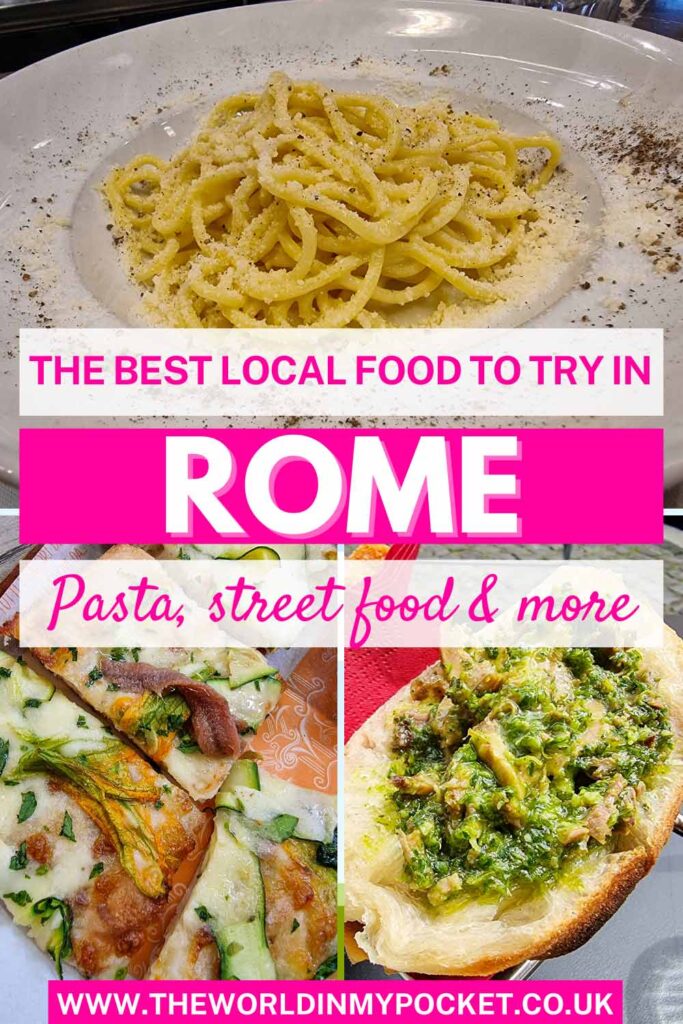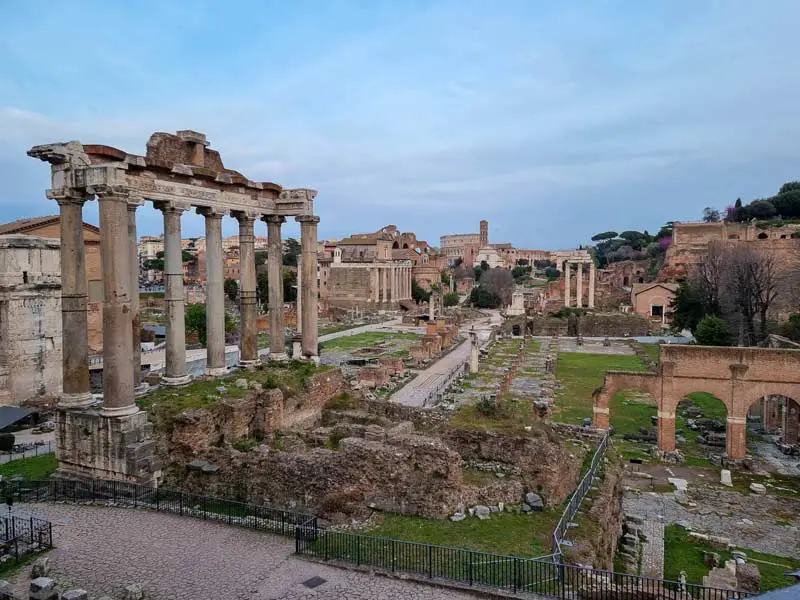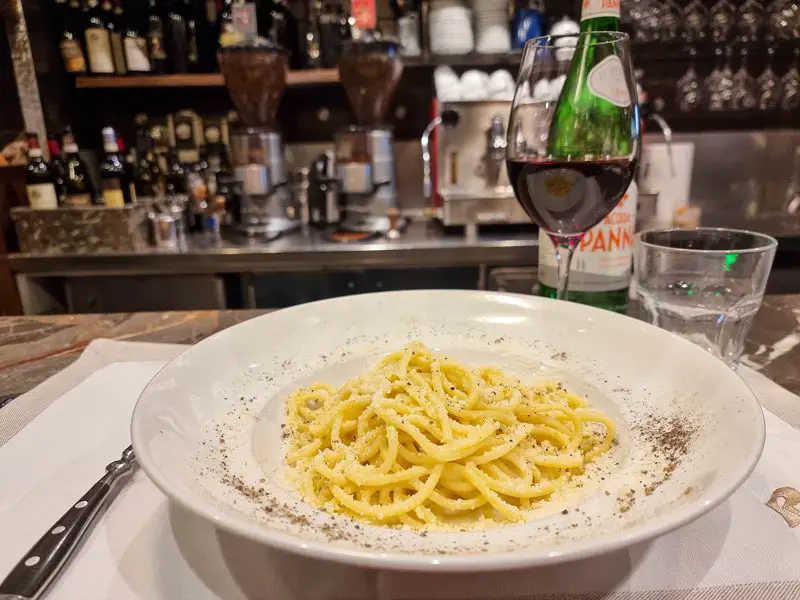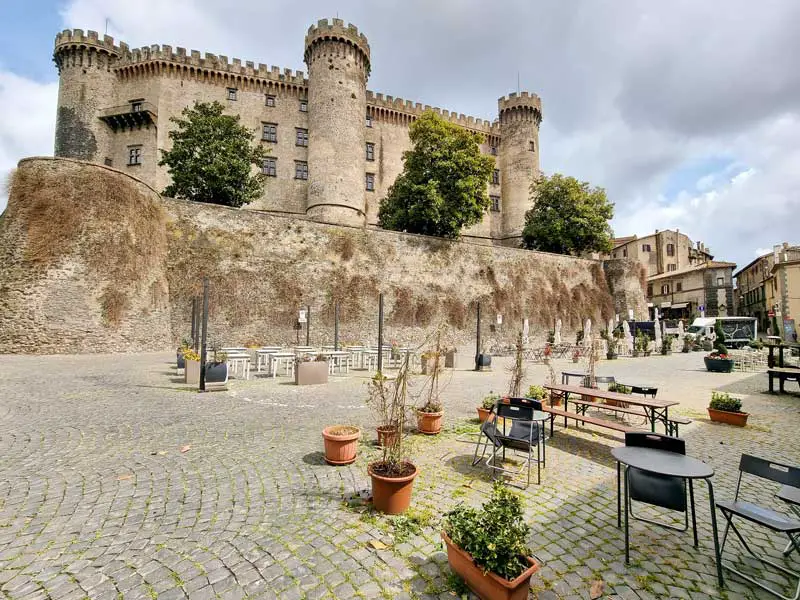Rome is my special city, my happy place in the whole world. I have visited the eternal city too many times to count. Each time, Rome welcomed me with open arms, friendly faces, and delicious food. On my last trip to the Italian capital, I focused mostly on what to eat in Rome, learning about the local and seasonal ingredients, as well as the typical dishes that are famous all over the world. I navigated the streets of the city trying to find the best food in Rome and the best local restaurants serving it.
I discovered typical Roman dishes that made my soul happy, prompting me to book another trip to Italy as soon as I returned home. Good food is always a panacea for the soul, and it can solve and give light to the most difficult situations. I can honestly say that a cone of creamy, pistachio gelato, can instantly put a smile on your face and make you feel happy. Local cuisine is always part of a city’s culture, and the traditional dishes can tell a lot about the history of the place you are visiting. And Rome couldn’t be a better example!
About the Food in Rome

The Roman cuisine is extremely flavoursome, even if most of the dishes only have a few ingredients. Take cacio e pepe for example, one of the best pasta dishes I have had in Rome. The sauce only has two ingredients, pecorino cheese and black pepper, but it’s probably the most delicious flavour combination you will taste in Rome.
The food in Rome is usually cooked with very few but high-quality ingredients. Many of the traditional pasta dishes include guanciale, which is a fatty pork jowl cured in salt, garlic, and aromatic herbs. When used for cooking, the fat melts in the pan giving the dish an extra deep layer of flavour.
But don’t stop at pasta, as Rome has so many other flavoursome dishes, such as oxtail stew, meatballs, pork roast, or artichokes. And, if you visit Rome during the artichoke season, your taste buds are in for a treat!
In this article I will tell you about what to eat in Rome and give you more information about the local dishes which you must try on your next holiday to the Italian capital.
Top Tips on Where to Eat in Rome

There are so many restaurants in Rome, and it can be daunting to decide which one to pick for your lunch or dinner. As a rule of thumb, the closest a restaurant is to a touristic landmark, the more expensive and the worse the food will be. Don’t eat at the restaurants in Piazza Navona, or at the ones along the streets leading to Fontana de Trevi.
If there is a waiter at the entrance louring you inside a restaurant, it’s a touristic place. Also, if the menu is listed outside in English and it’s big enough for you to see from 10 meters away, it’s a touristic place. In general, in the places which advertise English breakfasts or having names like Big Ben café, the food will not be good.
A great way to find a good restaurant is to ask a local. I asked the owner of the B&B I booked in Rome where I should eat in the area, and she gave me some amazing suggestions.
Another good tip is to look at the opening hours of the restaurant. Touristic ones will stay open all day long, whilst the ones aimed at locals will only open for lunch and dinner.
Years ago, on my previous trips to Rome, Trastevere was the hidden secret of the city, where the best food was to be found. Unfortunately, things seem to have gone really wrong, as during this visit I was shocked to see queues of over 50 people waiting to have lunch at some of the most popular restaurants in the neighbourhood.
I did have dinner at one of the most raved about restaurants in Rome, highly recommended by quite a few people. I booked it well in advance, but to be honest, I was disappointed. The food I had at a restaurant I stumbled upon by accident in a side street behind Piazza Venezia was so much better, and the service so much more attentive and personal.
What to Eat in Rome
Whilst you will find restaurants offering all the classic Italian dishes that Italy is so known for, such as lasagna or ragu alla Bolognese, I highly recommend you try the local cuisine when you are visiting Rome. As in Bologna you will find the best ragu, in Napoli you will find the best pizza, and in Rome, you will find the best spaghetti carbonara.
When you go to a restaurant in Rome you will notice that the menu has antipasto, primi, and secondi. This is because in Italy, pasta is eaten as a first course rather as the main dish of the meal. Antipasto is the starter section in which you will find dishes such as bruschetta, charcuterie boards to share, or my favourite, fiori di zucca which are deep fried courgette flowers with different fillings. In Rome I noticed that the most common fillings were mozzarella cheese and anchovies, or oxtail ragu. Fiori di zucca are amazing but I only recommend ordering them when they are in season, otherwise they will be fried from frozen.
The primo course refers to the pasta dishes. Most restaurants will have the four typical pasta dishes in Rome, as well as a few others, depending on what they specialise in. One of the restaurants I ate at in Bracciano, which specialised in fish, had a good selection of “primi di mare” – which is pasta with fish or seafood. Another restaurant I ate at in Rome, which specialised in traditional Roman cuisine, had a selection of earthy pastas, with ox tail sauce or porcini mushrooms.
Secondo is the main course of the meal, and it usually consists of hearty meat dishes. Unless mentioned in the menu, side dishes are separate. The traditional Roman artichoke is a side dish on most menus.
It is usual to end the meal with an espresso, or simply café in Italian.
It’s good to know that at the beginning of the meal, the waiter will bring bread and water to the table. These are not free, and they will be added to your bill at the end. If you don’t want them, just tell them straight away when they bring them.
Classic Pasta Dishes
Tonnarelli Cacio e Pepe

Cacio e pepe is one of the most traditional pasta dishes you will find in Rome. The sauce is made with only two ingredients: grated pecorino cheese and black pepper. This simple combination of cheese and black pepper creates an incredible flavour. It is one of the tastiest pasta dishes you can order in Rome, and a great choice for vegetarians.
Usually, you will find either tonnarelli or spaghetti cacio e pepe. Tonnarelli is a type of pasta typical to the Lazio region of Italy. It is made with eggs and has a long, thick shape, with an uneven surface which makes the sauce stick better to it. Spaghetti is a long, thin type of pasta, made from water and flour.
I had tonnarelli cacio e pepe at a very popular restaurant in Rome and whilst the starter was quite disappointing, the pasta tasted incredible. Both me and my table neighbour stopped talking and just enjoyed the explosion of flavour our taste buds experienced from the first bite.
Spaghetti Carbonara

Spaghetti carbonara is one of the most famous Italian pasta dishes. Originating in Rome, the carbonara is another simple but full of flavour traditional Roman dish. The sauce for carbonara is made with pecorino cheese, guanciale, and egg yolk.
It’s important to remember that there is no cream in carbonara. The creamy texture of the dish is given by the pecorino cheese mixed with the rich egg yolk. Carbonara may have only a few ingredients, but because of their flavours profile, it tastes divine.
It’s good to remember when you decide where to eat in Rome, that carbonara is made with guanciale, and not pancetta. If it’s made with pancetta, you are not eating at an authentic Roman restaurant.
I enjoyed rigatoni carbonara during my first evening in Rome, in the famous Pastificio Guerra near Piazza Spagna. It was one of the two choices of the day, and it did not disappoint.
Bucatini all’Amatriciana

Bucatini all’Amatriciana is another great variation of the classic cacio e pepe. In fact, all of the traditional Roman pasta dishes are based on cacio e pepe. In the case of amatriciana, the added ingredients are guanciale and San Marzano tomatoes.
Amatriciana is usually made with bucatini, which is another type of pasta popular in the Rome region. It is thicker than a spaghetti and has a hole in the middle that fills up with the tomato-based sauce. The sauce of the Amatriciana is enhanced with olive oil, white wine, and red chili peppers. It’s a great warming up dish when the weather is cold.
Pasta alla Gricia

I didn’t know much about pasta alla Gricia prior to ordering for lunch at a lovely restaurant overlooking the castle in Bracciano. I had seen it on menus before, but this version, with added artichokes, winked at me so I had to order it.
Pasta alla Gricia is practically cacio e pepe with guanciale as an extra ingredient. It’s a delicious combination of flavours.
Traditional Main Dishes to Try in Rome
Coda alla Vaccinara (Roman Oxtail Stew)

Coda alla Vaccinara is a humble but full of flavour typical Roman main dish. Its origin is in the Regola district in the centre of Rome, which in the Medieval times was home to the slaughterhouses of the city. The low rank butchers were usually paid in offal, which they would sell to the nearby osterias from Trastevere and Testaccio. This is how coda alla vaccinara was born.
The coda (cow’s tail) is slow cooked alongside large amounts of celery, onions, garlic, guanciale, tomatoes, white wine, and spices, until the meat falls off the bone. The end result is an extremely tender and flavoursome plate of food.
Coda alla vaccinara is messy to eat but it tastes delicious. When you order it, don’t refuse the basket of bread the waiters in Rome will usually bring to the table, as you will want to scoop out every bit of that delicious sauce.
Trippa alla Romana

Trippa alla Romana is a dish that you will either love or hate. This typical dish from Rome is made from beef tripe, guanciale, tomatoes, mint, and a generous amount of pecorino cheese. Just like the coda alla vaccinara, the trippa alla Romana has its origin is on the banks of the Tiber, where the slaughterhouses used to be. Back then, the trippa alla Romana would be eaten only on a slaughter day – which was Saturday. Today, some restaurants in Rome will still advertise this dish as a Saturday dish only.
Trippa alla Romana is a delicious dish if you can get over the fact that it is made with offal. The slow cooked tomatoes, the sofrito, the mint and the pecorino cheese create layers over layer of flavour.
Porchetta

Porchetta is a fantastic dish that can either be served in a restaurant alongside roast potatoes, or in a panino as a street food.
Porchetta is a slow roasted pork belly or loin roll, stuffed with liver, fat, and a bouquet of herbs, including fennel. Porchetta has been declared a traditional agricultural-food product in Italy, which is similar to the European protected designation of origin certification.
I tried porchetta in a restaurant, as a main dish. It was extremely rich, aromatic, and full of flavour.
Polpette alla Romana
Meatballs are a big staple of the cuisine in Rome and each local family has its own recipe that is passed down from generation to generation. They all have one thing in common though: the meatballs are always made with boiled or roast meat leftover from the Sunday lunch. In the past, the polpette was a dish made with leftovers: cooked meat which would be minced, and stale bread.
The meatballs are soft and juicy, finished in the pan with a rich tomato sauce. Sometimes, the meatballs are served alongside polenta cubes.
Carciofi alla Giudia
I was lucky that my last trip to Rome was in March, when the artichoke season is at its peak. Restaurants all over the old Jewish Quarter of Rome are displaying piles of artichokes in front of their terraces, to point out the freshness of their produce.
Carciofi alla Giudia is one of the most popular antipasto dishes not just in Rome, but all over Italy. This recipe is made using violet (also known as Romanesco) artichokes, which are bigger, round, and have no thorns. The vegetables are cleaned, then banged together so the leaves open up like petals on a flower. They are seasoned and then deep fried until they become crispy.
The Carciofi alla Giudia have a specific nutty taste and are extremely crunchy.
Carciofi alla Romana

Carciofi alla Romana is another popular dish to try in Rome in spring, when the artichokes season is in full bloom. This recipe used the same violet artichoke variety as the Carciofi alla Giudia, but the recipe couldn’t be more different.
In the Roman style artichoke recipe, the vegetable is cleaned and then stuffed with an aromatic bouquet of herbs, including the local mentuccia mint. Garlic and olive oil is added, before the artichoke is slowly cooked to infuse with all the wonderful flavours of the herbs.
Saltimbocca
Saltimboca is another Roman speciality that you will find very often in the restaurants around Rome. The name translates as “jump in mouth”, which kind of describes how good this dish is.
Saltimbocca consists of veal escalope rolled up with prosciutto and sage, cooked in butter and white wine.
Street Food in Rome
Pinsa Romana

Whilst Napoli wears the crown for the best pizza in Italy, Rome is known for the lightest, easy to digest pizza. The pinsa Romana has a very light and crunchy on the outside, and soft on the inside dough, topped with different ingredients, same as the classic pizza. Pinsa originates from the Roman Empire, and was popular amongst the poor peasants.
My favourite pinsa tasted in Rome was topped with courgette flowers, mozzarella, and anchovies.
Supplì

Supplì is another staple of the Roman street food cuisine. This small fried rice ball is similar to, but not the same as the Sicilian arancino. The supplì is made by mixing ragu or tomato sauce with arborio rice, with a filling of mozzarella cheese in the centre. The arancini are stuffed with ragu and enclosed in risotto rice, without any cheese in the centre. Also, arancini have saffron, whilst supplì does not.
Trapizzino

Trapizzino is the most Italian sandwich you could think of, made with deep fried pizza dough, and filled with different combinations of traditional Roman dishes such as polpette, coda alla vaccinara or artichokes.
Trapizzino is a relatively new culinary delight which was born in 2008 in a pizzeria in Testaccio neighbourhood. The popularity of this half sandwich, half pizza has spread across the oceans and it is now prepared and sold in countries such as America and Japan.
Trapizzino is a portmanteau of the world tramezzino (triangular sandwich) and pizza. And that is exactly what this is, a pizza triangle with a hot filling.
I tried this famous pizza sandwich at the place where it was invented, “Trapizzino”, which now uses many different fillings, some traditional, some not. I went for a more unusual filling, the beef tongue in green salsa which was divine.
Sweet Treats
Maritozzi

During my last trip to Rome, I got into the habit of having a small maritozzo for breakfast, alongside my cup of coffee. You can only find these pastries in Rome.
Maritozzi are buns that have been cut in two and then filled with whipped cream. They are sold as bit or small, or with candied fruits instead of the whipped cream. They are delicious! Don’t worry about the calories, as you will burn them off in just half an hour while walking on the hilly streets of Rome.
Ciambelline al Vino

I was offered a plate of ciambelline al vino as a dessert on the house, at one of the restaurants I ate at in Rome. They came alongside a pot of melted dark chocolate, to dip them into.
These small crunchy biscuits are typical to Rome and are meant to be dipped in wine, but they are as delicious dipped in chocolate too.
Gelato

Gelato is not a typical Roman dessert, but you are in Italy, so you have to try as many flavours as possible. Not all gelato in Rome is worth your money though!
I usually go to the same place for Gelato, as even though I tried many different gelato shops, none topped the one I get from Giolitti.
It’s actually quite easy to tell if a gelato parlour is selling natural ice cream. Just look at the colour of the pistachio gelato. If it’s green-brown-ish, then it’s a good place. If the pistachio ice cream is bright green, go somewhere else. Natural pistachio gelato will never be bright green.
Extra
Wine from Lazio

I like to have a glass of red wine with my lunch or dinner, and whilst visiting Rome, I chose local wines from the Lazio region. As they are not that well known, I don’t think I had tried them before this trip.
And what a lovely surprise I had, as all the local wines I tried were delicious and had a very rich, bold taste.
How to Best Experience the Food in Rome
Join a Food Tour
A great way to sample the traditional food in Rome in a short time, is by taking a food tour. There are so many different options of food tours in Rome, from street food bites to three course meals. I personally prefer the tours run by Eating Europe. They have a fantastic Taste of Testaccio tour, which takes you around the original foodie neighbourhood of Rome – you can check more details by clicking here. Their other tour in Rome includes wine tasting in a 100-year-old cellar, besides many delicious stops. I have taken two different foodie experiences with Eating Europe (a cooking class in Florence about which you can read here, and a food tour of Prague about which you can read here), and I couldn’t recommend them highly enough if you are interested in an extremely local tour, run by locals. I would have loved to experience one of their Rome tours as well, but my schedule didn’t allow it on this occasion.
Other options for food tours in Rome are:
Take a Cooking Class
Another great way to learn about the local cuisine is to take a cooking class with a local chef. There are plenty of options for classes. When you pick one make sure that the menu includes Roman traditional dishes.
Here are some options:
- Pasta and tiramisu cooking class
- Three types of pasta cooking class
- Pasta and ravioli workshop in a traditional pastificio
Like it? Pin it!
Disclaimer: Some of the links on this website are “affiliate links.” This means that if you click on the link and do a purchase, I will receive an affiliate commission at no extra cost for you. This helps me keep my website running and continue to share my travelling knowledge with you. I thank you for booking your flights or hotels using the links on my website. Regardless, I only recommend products or services I use personally and believe will add value to my readers.






OMG! Now my mouth is watering!! We are planning a trip to Italy next year and I am saving this as a reference!!